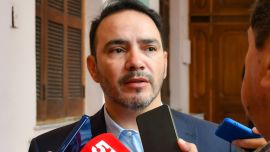Two important anniversaries this week, both round numbers – the 45th anniversary of the 1976 coup last Wednesday and the 30th anniversary of the Mercosur regional trade bloc yesterday – so which to choose? If this column is to be true to its slug, the choice has to be Mercosur – that Ruby Tuesday of 1991 fell during my first Easter week as Buenos Aires Herald co-editor with plenty of memories, whereas I was nowhere near Argentina in 1976 (hearing the coup news in the southern Dutch city of ‘s-Hertogenbosch, if anybody wants to know) so that story is far better left to the surviving heroes of Robert Cox’s newsroom. The Mercosur anniversary also happens to be fresher in the news than Memory Day, which in no way makes it more important.
The three decades seem to offer little to celebrate for a dysfunctional Mercosur doomed by the coronavirus pandemic to a tense virtual summit yesterday and “sunk in irrelevance,” according to the headline of a think piece by prestigious analyst Andrés Malamud, but this columnist proposes to defy the prevailing negativity by insisting that Argentina needs more Mercosur, not less. The post-pandemic world (whenever it comes) is going to find an isolated and shrunken Argentina with a sky-high country risk (which this week’s developments can only make more stratospheric) and its 2020 investment plunging 13 percent according to the official data released by the INDEC national statistics bureau last Tuesday.
A hopeless outlook but Mercosur offers a possible escape route back into the world – teaming up with Brazil, not only a much larger economy but also less diminished (contracting under two percent since 2017 as against around 15 percent in Argentina’s case), would offer overseas investment juicy economies of scale, especially for food production. Anchoring the economy in populist nationalism, a battered domestic market and import substitution would replicate the error of Brexit – approaching China or the European Union (nominally already a free-trade agreement partner for the last two years but with parliamentary ratification light years away) as part of a US$2.4-trillion trade bloc would be an entirely different ball game, attracting investment for sorely outdated infrastructure quite apart from boosting exports.
A bleak post-pandemic future but a much brighter beginning in the past century uniting almost 200 million people 30 years ago – Mercosur clicked into gear in the age of the Washington Consensus. It is important to recall that Mercosur was a political vision ahead of economic, like the European Union before it (consigning ancestral wars to the past ahead of moving towards a common market). The Southern Cone trade bloc was very much a post-dictatorial creation (the Treaty of Asunción hosts had only seen the back of Alfredo Stroessner 26 months beforehand after 35 years) – Raúl Alfonsín and his Brazilian colleague José Sarney, who laid the foundations for Mercosur with their joint statement at Iguazú bridge in 1985, were eminently products of the political world with scant commercial perspective.
But by 1991 the two regional giants were headed by the far more economically minded Carlos Menem and Fernando Henrique Cardoso, enabling Mercosur to progress rapidly towards the Protocol of Ouro Preto in 1994, laying various institutional planks and (above all) reaching agreement on a common external tariff, which provided the basis for a customs union (imperfect then and imperfect now while never graduating to a common market). Yet these successes were in many ways also the seeds of failure. The empathy between Menem and Cardoso worked against the urgency of institutional consolidation, especially defining mechanisms for conflict resolution beyond the presidential level (ditto for macroeconomic coordination). The common external tariff of 14 percent (almost trebling the current world average) enshrined a protectionist model catering to the manufacturing lobbies of São Paulo and the Greater Buenos Aires industrial belt while perpetually blocking the Mercosur entry of a far more globalised Chile.
But most problems still lay ahead in the early years – the bloc’s trade volume grew annually by 20-plus percent in the first seven years while in the decade of the global commodity price boom as from 2003 foreign direct investment more than quadrupled. The first real setback came with Brazil’s maxi-devaluation of 40 percent in early 1999, blamed (with some accuracy) for triggering the collapse of convertibility here. But the commodity price boom caused a more permanent change in direction by bankrolling a wave of centre-left governments throughout the region spearheaded by the Venezuela of Hugo Chávez as its most extreme version. The first fruit of this paradigm shift became visible at the 2005 Summit of the Americas in Mar del Plata where Mercosur spurned the hemispheric American Free Trade Agreement (AFTA) to the humiliation of George W. Bush. Venezuela applied for accession the following year, entering in 2012 via the suspension of Paraguay (on the grounds that the parliamentary vote of no confidence against Fernando Lugo disqualified it as a democracy). But quite apart from its own democratic shortfalls, Venezuela never bothered to comply with Mercosur trade norms and has been suspended since 2017.
Yet the commodity price boom this century has also been a paradigm shift in commercial as well as political terms. At the birth of Mercosur, Brazil accounted for 42 percent of all Argentine merchandise trade, a percentage now down to 26 percent – all those soy exports to China are the obvious explanation. But the other Mercosur partners have also changed in this century with the Brazil of the 2014 World Cup and the 2016 Olympics entertaining global aspirations while the smaller countries yearn for more flexibility. Only 15 percent of regional trade is within Mercosur as against an average of 30 to 40 percent for other major trade blocs worldwide. Mercosur will have problems selling itself to the rest of the world while it cannot sell to itself.
Hard to think of the current presidents of Mercosur being on the same page if they cannot even be in the same room due to coronavirus – still early days to float post-pandemic prospects. For all its flaws the bloc remains a gigantic vision with its market of 260 million people (even minus suspended Venezuela) representing almost 70 percent of the South American economy although eclipsed by the emergence of two far bigger monsters last year – the Regional Comprehensive Economic Partnership (RCEP) of the Asia-Pacific world and the United States-Mexico-Canada Agreement (USMCA) replacing the North American Free Trade Agreement (NAFTA). Time for Mercosur to stop living up to that old joke long describing both Argentina and Brazil as “a land of the future – always has been, always will be.”



















Comments